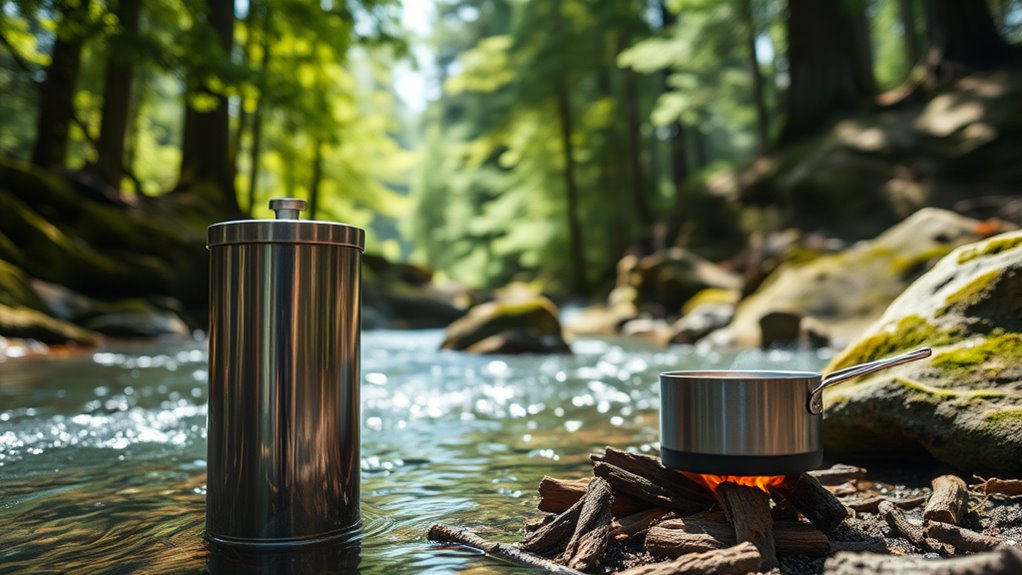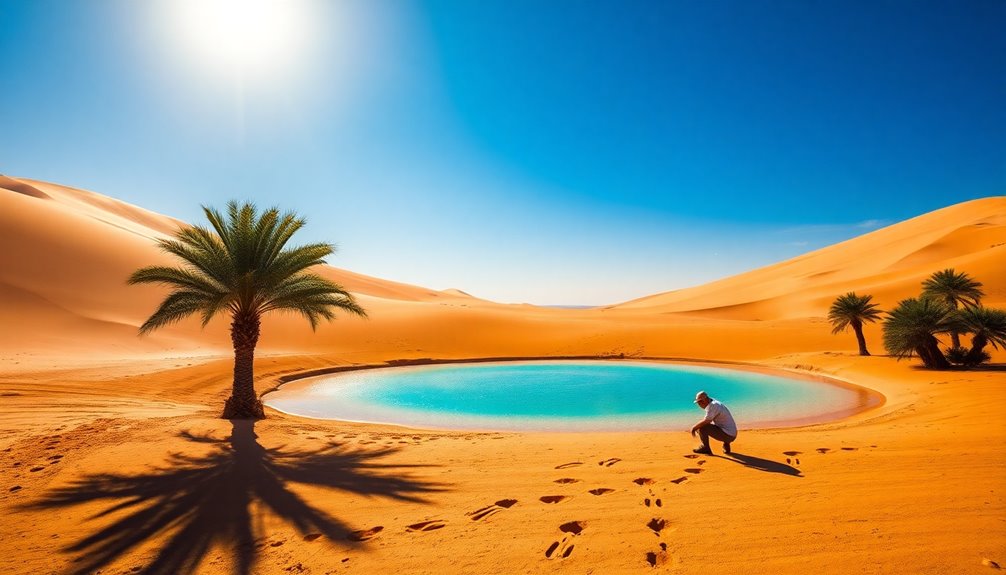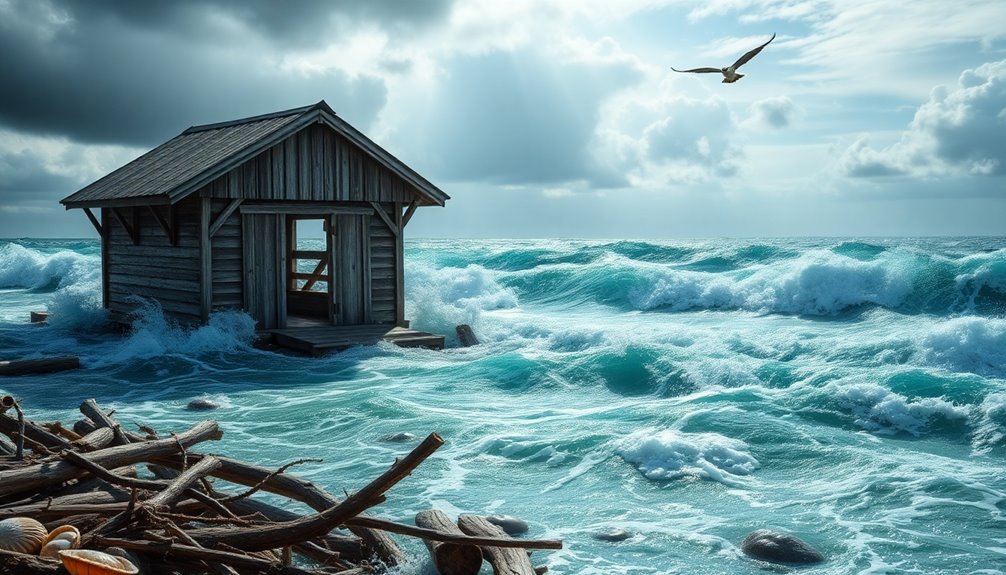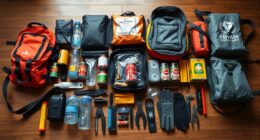When you're in the wilderness, safe water purification is crucial to avoid health risks from contaminated sources. Boiling water is the most reliable method, as it kills pathogens effectively. You can also use chemical treatments like iodine or chlorine for quick purification. Filtration can improve taste, but may not remove all viruses. UV light is another effective option. To ensure you're prepared, it pays to learn about all available purification methods.
Key Takeaways
- Boiling water for at least one minute eliminates most pathogens, making it a reliable purification method in the wilderness.
- Use portable filters to improve water taste and appearance, but remember they may not remove viruses.
- Chemical disinfectants like iodine or chlorine effectively kill microorganisms but may leave an aftertaste; follow dosage instructions carefully.
- Consider UV light purification as an effective method, especially when combined with filtration, but ensure you have the necessary equipment.
- Always collect water from fast-moving streams or springs to minimize contamination risks and clean your collection gear regularly.
Importance of Water Purification in the Wilderness
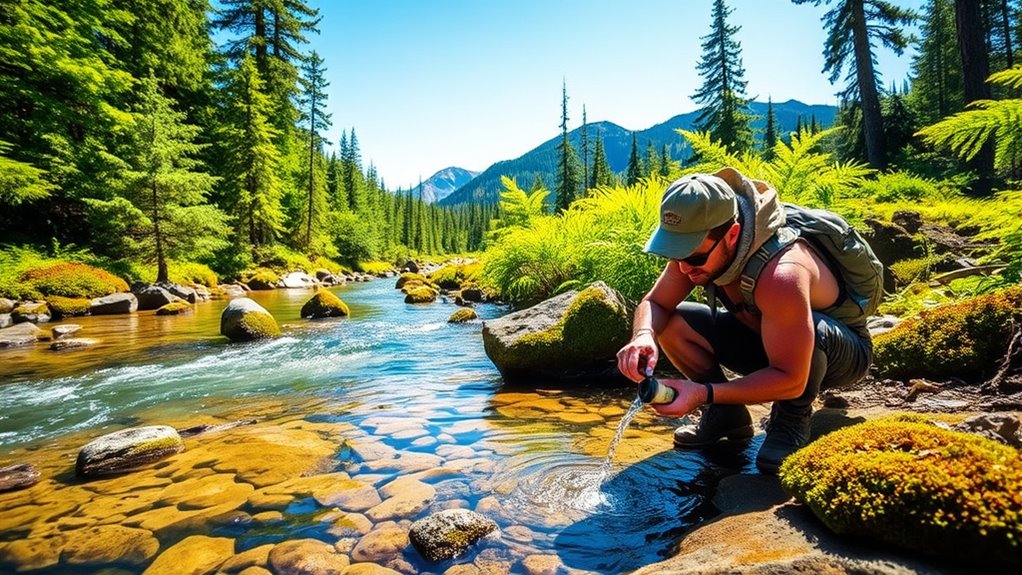
When you're out in the wilderness, the importance of water purification can't be overstated. Drinking contaminated water can lead to serious health risks like waterborne illnesses, which can be life-threatening.
Access to clean water is crucial for survival; without it, dehydration can set in quickly. Environmental factors, such as agricultural runoff and animal waste, often compromise water sources.
Access to clean water is vital for survival; without it, dehydration can rapidly become a serious threat.
Purifying water not only prevents immediate health issues but also safeguards you against long-term dangers. Learning various purification techniques is essential for outdoor enthusiasts, ensuring you can hydrate safely.
Whether you're boiling, using filters, or chemical treatments, you must prioritize this skill to enjoy your adventure without jeopardizing your health. Stay safe out there by treating every water source.
Common Pathogens Found in Wild Water Sources

Understanding the common pathogens found in wild water sources is crucial for anyone venturing into the outdoors.
Bacterial threats like Legionella, Pseudomonas, and Vibrio can lead to serious illnesses, including pneumonia and gastroenteritis.
Protozoan parasites such as Giardia and Cryptosporidium pose significant risks, often causing severe intestinal distress.
Viral pathogens like Norovirus and Hepatitis A can also contaminate water, leading to gastrointestinal and liver issues.
Additionally, parasitic threats like Dracunculus medinensis and Schistosoma can cause debilitating conditions.
Environmental factors like climate change, wildlife presence, and agricultural runoff further increase the risk of contamination.
Remember, knowing these pathogens helps you make informed decisions about water safety during your outdoor adventures.
Stay vigilant and prioritize purification!
Boiling: The Most Reliable Purification Method
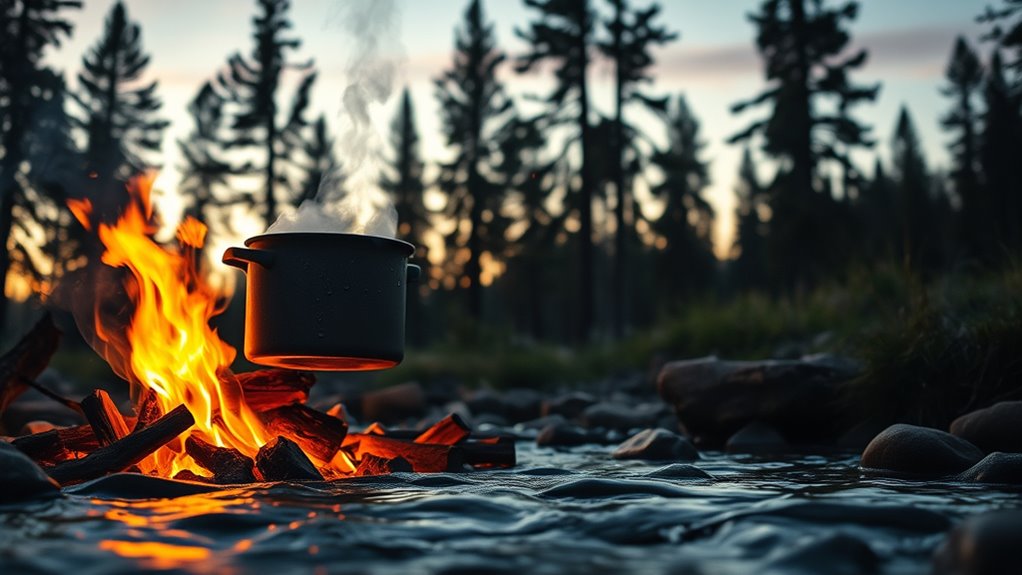
Boiling water remains one of the most reliable methods for purification, as it effectively eliminates harmful pathogens like bacteria, viruses, and parasites. You only need a heat source and a container, making it simple and accessible in the wilderness.
Boiling water is a simple and effective way to purify it from harmful pathogens in any wilderness setting.
Start by gathering your supplies, then filter out larger debris if possible. Bring the water to a rolling boil for at least one minute—three minutes if you're at a high altitude.
After boiling, let the water cool before drinking and store it in a clean, covered container to prevent recontamination.
While boiling won't remove chemical contaminants or improve taste, it's a low-cost, chemical-free option that's widely trusted and easy to perform, even without specialized skills.
Chemical Treatment Options for Water Purification

While many outdoor enthusiasts rely on boiling for water purification, chemical treatment options offer a lightweight and effective alternative.
Iodine and chlorine are the most common chemicals used, available in liquid or tablet form for easy portability. They effectively combat bacteria, viruses, and some protozoa, but keep in mind they're less effective against cryptosporidium.
While these methods are cost-effective and quick, they can alter the taste of your water, potentially discouraging you from drinking. Always follow instructions carefully, adjusting dosage for cloudy or cold water.
Remember, combining chemical treatments with other methods can enhance their effectiveness, and adding flavorings post-treatment can make your water more palatable.
Stay safe and hydrated on your adventures!
Effective Filtration Techniques for Clean Water

If you're looking for immediate access to clean drinking water in the wilderness, effective filtration techniques are a reliable option. Filtration removes sediment and harmful chemicals, improving taste and appearance.
Effective filtration techniques offer immediate access to clean drinking water, enhancing taste and removing harmful chemicals in the wilderness.
You can choose from various filters, including ceramic, paper, and membrane types, each targeting different pathogens. While these filters are generally bulkier and more expensive than chemical treatments, they allow for instant consumption without waiting for further treatment.
For practical use, consider pump filters for manual efforts, gravity-fed filters for groups, or inline filters for portability. Remember, most filters don't remove viruses, so you may need additional treatment in high-risk areas.
Regular maintenance, like backwashing, keeps your filter efficient for multiple uses.
Ultraviolet Light Purification Explained
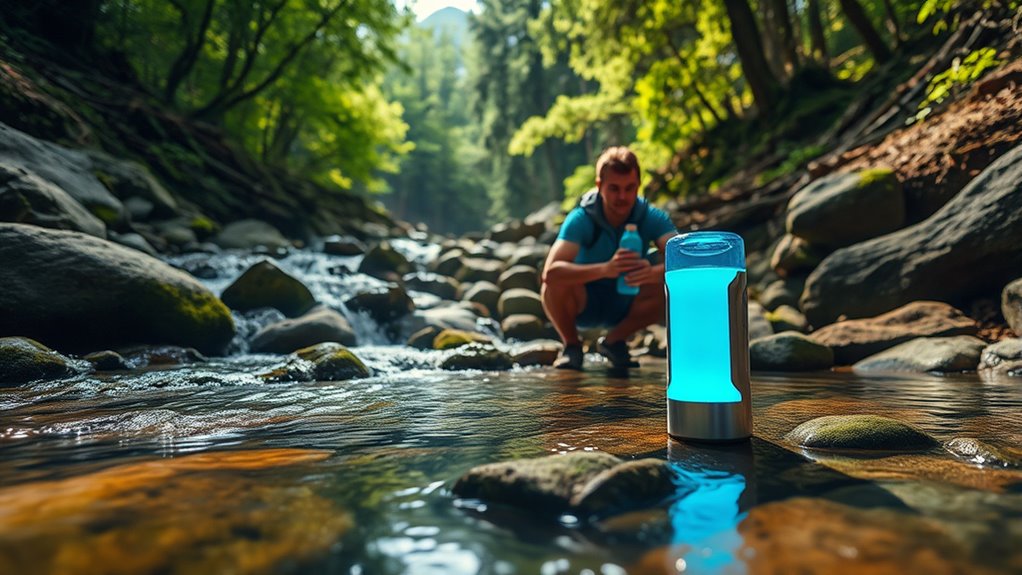
Ultraviolet (UV) light purification offers a powerful method for ensuring your drinking water is free from harmful microorganisms.
Using UV light at 254 nm, this system penetrates and disrupts the DNA of bacteria, viruses, and parasites, preventing their reproduction. The process occurs in a reactor chamber where water flows past a UV-C lamp protected by a quartz sleeve, allowing effective disinfection without altering taste or odor.
It's an eco-friendly solution that doesn't add chemicals and requires minimal electricity, making it ideal for various environments. However, ensure the water is clear, as turbidity can reduce efficacy.
With easy maintenance, including just an annual lamp change, UV purification is a reliable choice for wilderness survival.
Other Methods of Water Purification
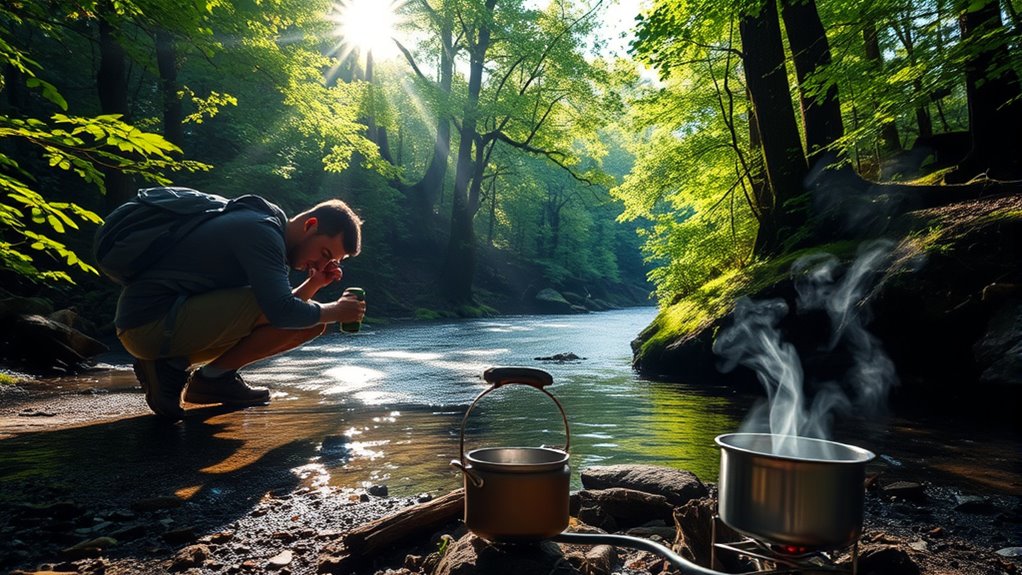
When you're out in the wilderness, having reliable water purification methods is crucial for your survival.
Chemical treatments like iodine tablets and chlorine drops can effectively disinfect your water but require precise timing and dosing.
Portable filtration systems, such as LifeStraw or gravity filters, allow you to remove pathogens while you drink directly from the source.
For a more natural approach, consider plant filtration or sedimentation to improve water clarity.
DIY methods like sand and rock filtration or cloth filtration can help, though they may not fully purify your water.
Always follow up with boiling or additional treatments to ensure safety.
Adapting these methods can provide you with safe drinking water, even in challenging environments.
Risks and Limitations of Various Purification Methods
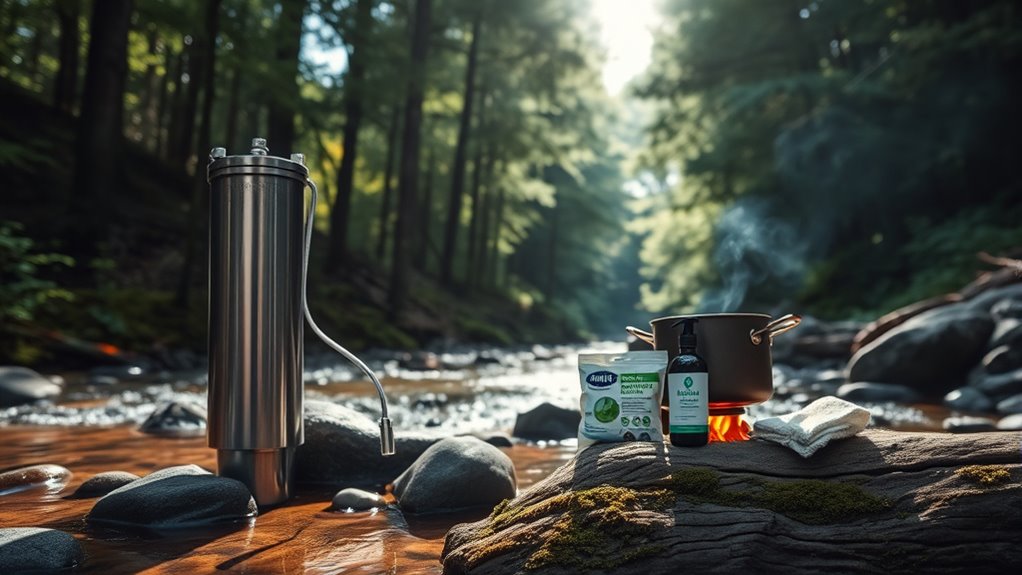
While water purification methods can significantly reduce health risks, each technique comes with its own set of limitations and potential pitfalls.
Boiling requires a heat source and doesn't eliminate chemical pollutants.
Boiling water is effective but cannot remove chemical pollutants and needs a reliable heat source.
Filtration may not remove all pathogens and can lead to re-contamination if not stored properly.
Chemical treatments, while effective, can taste unpleasant and have expiration dates.
Other methods, like UV light or solar stills, depend on environmental conditions, which may not be reliable.
Plus, naturally occurring purification methods lack consistency.
With approximately 90% of the world's water contaminated, understanding these risks helps you make informed decisions about water safety in wilderness situations.
Always consider the specific limitations of each method you choose.
Best Practices for Safe Water Collection and Treatment
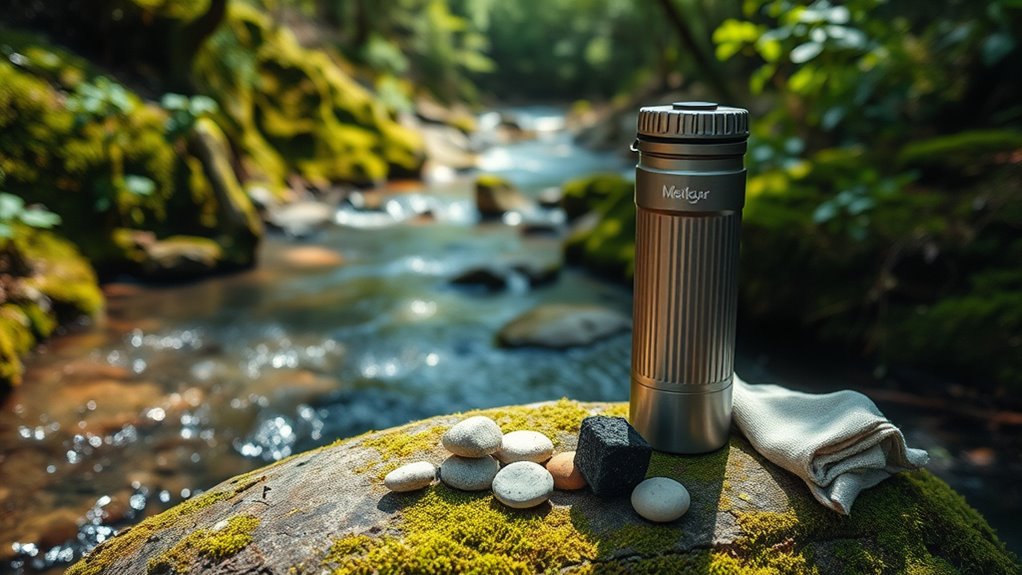
Understanding the risks and limitations of water purification methods sets the stage for adopting best practices in safe water collection and treatment.
Start by assessing your water source for contamination signs, avoiding stagnant pools and areas with algae. Opt for springs or fast-moving streams, and always wear protective gear to prevent cross-contamination. Regularly clean your collection equipment to maintain its effectiveness.
For treatment, boiling is a reliable method; just ensure you boil for at least one minute.
Consider portable filters for pathogens, but know they may not eliminate viruses. Chemical disinfection can kill microorganisms, though it might leave an aftertaste. Lastly, UV light offers an effective option when paired with filtration.
Always prepare for emergencies with improvised methods if needed.
Frequently Asked Questions
Can I Purify Saltwater for Drinking?
Yes, you can purify saltwater for drinking, but you'll need specific methods.
Distillation is effective, as it heats the water, separating the salt from the vapor. Reverse osmosis filters out salt using membranes.
If you have sunlight, consider solar desalination or a solar still.
Remember that each method has its pros and cons, so choose one based on your resources and needs. Always ensure the water meets health standards before drinking.
How Do I Know if My Water Is Safe?
When it comes to water safety, think of it like a treasure hunt; you need to know where to dig.
Start by visually inspecting the water for clarity and avoid stagnant pools. Look for signs like animal tracks or vegetation, which may lead you to safer sources.
What Is the Best Purification Method for Backpacking?
When you're backpacking, the best purification method often depends on your needs.
If you're looking for portability and quick access, a Sawyer Squeeze or LifeStraw works great. For larger groups, consider the Platypus GravityWorks for its high volume.
If you prefer chemical treatments, Aquamira is effective without a strong taste.
Always remember, boiling water is the most reliable method, but it requires time and a heat source.
Choose what fits your adventure best!
Can I Reuse Water Purification Tablets?
You might think reusing water purification tablets could save you money, but that's not the case.
They're designed for single use, and their effectiveness diminishes after the first treatment. While it may seem convenient, using them again won't guarantee safe water.
Instead, consider investing in reusable filters or UV purifiers for a more sustainable solution.
How Can I Store Purified Water Safely?
To store purified water safely, choose food-grade containers made from stainless steel or BPA-free plastic.
Ensure they're portable, seal tightly, and are durable. Keep your containers protected from direct sunlight and extreme temperatures.
Regularly inspect them for wear and clean them to prevent bacterial growth.
Store water in shaded, well-drained areas, close to your campsite but away from potential contaminants.
Label your containers to indicate their contents and purification status.
Conclusion
When you're out in the wild, remember that nearly 1 in 10 untreated water sources can harbor harmful pathogens. By using reliable purification methods like boiling or filtration, you can enjoy nature without the fear of getting sick. Always stay vigilant about your water collection and treatment practices. With just a little effort, you can ensure that every sip you take is safe, allowing you to fully immerse yourself in the beauty of the wilderness.

